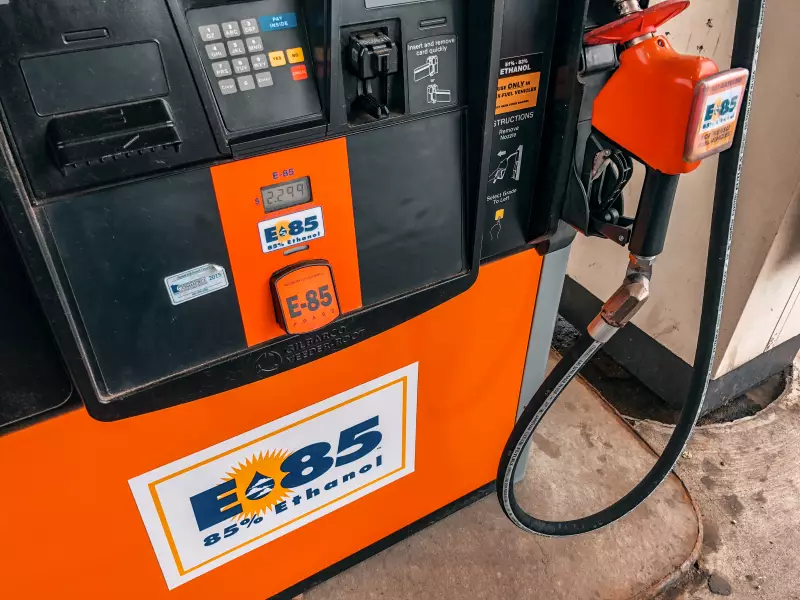The debate around modern vehicle fuel types primarily revolves around electric and gasoline engines. We’d like to introduce a third, not-so-new contender into the ring: Flex Fuel.
Although flex fuel has been around for decades, it doesn’t command a large portion of the market. According to the Department of Energy, there are just under 21 million flex-fuel vehicles on US roads out of roughly 283 million.
However, the flex fuel industry does attend to several rapidly growing issues. Vehicles using this fuel positively impact the environment and specific job markets. However, the technology has other unique drawbacks that may deter consumers from making the big buy.
What Is Flex Fuel?
Flex fuel is a top-graded ethanol and gasoline blend used in automobiles. There are varying degrees of mixing, but flex fuel specifically refers to products with a 51—to 83 percent ethanol inclusion. It is typically the highest-quality fuel you’ll find at the gas station pump.
Ethanol is a plant-based fuel source that gained traction as a more environmentally friendly alternative. You might remember the old attempts at vehicles powered by vegetable oil. Flex fuel can be considered a far more sophisticated version of those experiments.
That said, ethanol-based fuels go back a lot farther than you think. In 1908, the Ford Motor Company’s Model T accepted gasoline and ethanol. However, the vehicle didn’t make a lasting impact due to the relatively low interest in environmental concerns at the time.
Ford continued spearheading the ethanol movement and created modern flex fuel in 1996. Only a decade later, nearly all the most prominent automotive manufacturers included a flex fuel option in their catalog.
Is Flex Fuel the Same as E85?
In the US, flex fuel and E85 are synonymous. Some confusion stems from the fact that flex-fuel does not contain 85 percent ethanol. Instead, the ratio of gasoline to ethanol varies between 51 and 83 percent, depending on the weather and surrounding climate.
For example, flex-fuel includes lower amounts of ethanol in cold winters because ethanol is a more stable substance than gasoline. It takes more energy to combust when cold, which makes starting an engine difficult. Lowering the percentage of ethanol combats this problem without losing all the benefits of the fuel.
The term flex fuel is primarily used domestically. Other countries refer to the high-quality ethanol blends solely as E85 and define it as fuel containing “up to 85 percent ethanol.”
What are E10 and E15?
E10 and E15 are lower-level blends of ethanol fuel. Both contain smaller proportions of ethanol including 10 and 15 percent ethanol respectively. These fuel types were the precursors to the E85 we use today.
Vehicle owners must still have the appropriate vehicle type to use E10 and E15. Even smaller traces of ethanol can suffer damage in the gaskets and O-rings.
How Does Flex Fuel Work?
We caution against filling your tank with flex-fuel before your next outing without doing some research. While it may seem like a conscientious choice, not all vehicles are well-equipped to use ethanol. While most modern models can run on this fuel, too much can corrode parts of your fuel system.
The skeleton of a flex fuel vehicle (FFV) isn’t too different from that of a gasoline one. It uses an internal combustion setup but may require ethanol-specific parts to detect the fuel’s contents and adjust accordingly.
A flex fuel sensor quantifies how much ethanol is blended in. The exact amount of ethanol in your fuel will vary depending on the time of year, and this device allows your vehicle to function normally at any ratio.
The sensor’s results are translated into volts by the Ethanol Content Analyzer (ECA), which are fed into the Electronic Control Unit (ECU).
Finally, the ECU dynamically calibrates the engine. Since the ECU is a built-in computer, it can dynamically update itself and change how various parts of the vehicle operate. This process is repeated throughout your drive so your car remains efficient.
Is My Car Flex Fuel Compatible?
General Motors was the first to put yellow gas caps on its flex-fuel vehicles in 2006. Most manufacturers followed suit and also put additional markers, such as stickers, on the fuel door to inform owners.
Pros and Cons of Flex Fuel
There are advantages and disadvantages of using flex fuel in vehicles, helping you to understand whether an FFV might be the right choice for your driving needs
Environmental Benefits

In 2022, transportation accounted for 29 percent of US-produced greenhouse gas emissions. While not completely emission-free, flex-fuel is a significantly cleaner option since it is mostly composed of crop byproducts. The difference lies in the life cycles of gasoline and ethanol.
Gasoline is created from petroleum, which is drilled out of the earth with oil rigs. No part of the extraction or refinement process offsets the eventual carbon emissions produced from gasoline.
In contrast, flex-fuel is created chiefly from crops that can capture released carbon emissions. According to the US Department of Energy, the crops grown to create flex fuel reduce their eventual emissions by roughly 40 percent.
Reduced Cost and Tax Breaks
The US Department of Energy is on a mission to reduce the country’s transportation emissions. It offers tax breaks for businesses and citizens who buy alternative fuel vehicles and install charging stations at their homes.
One of these programs is the Alternative Fuels Excise Tax Credit. It applies to fuel sources like natural gas, liquefied hydrogen, and products derived from biomass like ethanol. This credit was meant to end in 2021 but has been extended through the end of 2024.
Additionally, flex-fuel is cheaper per gallon than pure gasoline. The Kelley Blue Book found that, on average, E85 costs 60 cents less than regular unleaded gasoline.
However, people must consider that flex-fuel gets fewer miles to the gallon than gasoline, and the efficacy will change depending on the ratio of ethanol. So, you’re not always getting a better deal with this option.
Improved Domestic Energy Security
Seventy percent of US transportation relies on petroleum consumption. This trend increases the country’s dependence on foreign oil imports to sustain the transportation sector. A more widespread adoption of domestically produced ethanol diversifies US energy sources and strengthens the country against an unstable fuel supply.
Despite these benefits, flex-fuel isn’t a perfect energy source. It faces problems like lowered energy efficiency and lack of availability. Here are the most noticeable downsides of ethanol-based fuels.
Decreased Fuel Economy
Ethanol has a lower energy content than regular gasoline. This means that flex-fuel vehicles will only achieve 70 to 85 percent efficiency compared to traditional vehicles. The efficacy will change depending on the ratio of ethanol used, and a 10 percent inclusion should operate identically to unleaded gasoline.
Financially, this reduced mileage is offset by Flex Fuel’s lower price tag. The only other problem is that drivers may find it annoying to stop more frequently to fill up.
Lower Availability and Pumps
Flex fuel isn’t a popular investment for gas stations due to its lower price tag and limited popularity. Nationwide, the US has 145,000 fueling stations but flex fuel is only available at about 4,000 of them. That gives drivers less than a 3 percent chance of finding one on the road.
The good news is that flex-fuel vehicles do not require ethanol to function. These cars can run perfectly well on 100 percent gasoline, and flex-fuel is a personal choice that can be taken when available.
Thins Out Crop Supply
You don’t have to search very hard to find cases of food shortages all around the world. Farming is a volatile business that’s severely affected by events like droughts, flooding, invasive species, crop disease, and countless other threats.
In the US, ethanol is primarily produced from corn and sugar, meaning a portion of the supply is earmarked for fuel. Other sectors that rely on corn, such as animal feed, may experience scarcity and price increases.
Can You Mix Flex Fuel and Regular Gas?

Yes, you can add gasoline to your existing flex fuel and vice versa. The changes to a vehicle’s fuel system are meant to accommodate the addition of ethanol. Nothing is altered that would affect how the vehicle handles pure gasoline.
Compatible vehicles are safe with up to an 83 percent ethanol ratio. They are not tested for mixtures surpassing that proportion, but this shouldn’t be an issue unless you’re adding pure ethanol to your tank.
We recommend only diluting your fuel yourself if your vehicle is equipped with a sophisticated sensor that tells you your fuel’s ethanol levels.
Conclusion
Flex fuel is a promising alternative to regular unleaded or diesel gasoline. It utilizes a mixture of ethanol and gasoline to provide significant environmental benefits.
This earth-friendly alternative does have its own problems. Drivers will experience lower mileage and may not find a suitable gas station on the road. However, the downsides add up to inconveniences rather than serious dealbreakers.
The decision to use flex-fuel depends on multiple factors, such as the individual’s driving habits and ethics. While it isn’t the perfect choice for everyone, flex-fuel does add much-needed diversity to US fuel sources and is likely to grow in popularity alongside other alternative fuel initiatives.








![Best Sites to Check a Car’s History [2025 Review]](https://media.infopay.net/thumbnails/K8lMeG2QLjE46LPqZlmoi6SunKKdT5qvlaRZk6e1.webp)










![Best Sites to Check a Car’s History [2025 Review]](https://media.infopay.net/thumbnails/K8lMeG2QLjE46LPqZlmoi6SunKKdT5qvlaRZk6e1-w356.webp)
